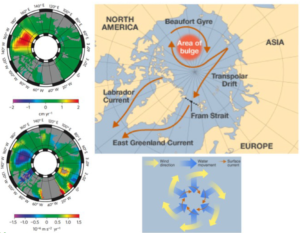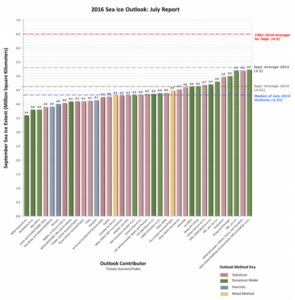By Michel Tsamados, Lecturer in Polar Observation & Modelling/Rheology, UCL
I have now been at CPOM for a little more than 6 years, which is nearly as long as CryoSat-2 has been orbiting around our planet sending us the most accurate and extensive data from the polar regions. When I started at UCL in May 2010, less than 3 weeks after the launch of CryoSat-2, the atmosphere was still one of exuberance. I can clearly remember Duncan Wingham, Seymour Laxon, Katharine Giles and Andy Ridout producing and looking at the first maps of ice thickness extending as far north as 88°.
In fact, it was already becoming clear that the ice mission was going to exceed expectations and that new avenues of research were also opening up in terms of ocean applications, including bottom topography and ocean circulation in ice covered conditions (Figure 1) not to mention ground-breaking results regarding the evolution of land ice.
Figure 1 – The spin up of the Arctic Ocean as first observed by CryoSat-2 (BBC News article January 2012)
On the modelling front, the team assembled by Daniel Feltham was maturing, with new exciting developments being published both for the thermodynamics (melt ponds, Flocco et al. 2010) and for the dynamics (anisotropic rheology, Wilchinsky and Feltham, 2006) of sea ice.
For me, it was a new beginning, leaving behind (at least temporarily) the flow of amorphous solids at the atomic scale (my PhD) to study the flow of another amorphous system composed of much larger “grains” – or floes – of hundreds of metres – sea ice. Recently I have tried to bring the Earth Science and Material Physics communities together by organising a CECAM workshop on the flow of amorphous solids.
CPOM wouldn’t be what it is today without the great work carried out by Duncan, Seymour and Katharine at UCL. Today, CPOM is going from strength to strength with a new directorate at Leeds University led by Andy Shepherd, a group at Bristol led by Tony Payne, and a modelling group led by Daniel Feltham at Reading University – where I spent nearly 2 years working among other things on the implementation of a new form of drag parameterization over sea ice.
At UCL, our group has seen several developments with the appointment of two new academic positions, Julienne Stroeve and myself, the submission of three PhD theses (Tom Armitage, Rachel Tilling and Sam Thomas), new PhD students Isobel Lawrence and Mark Shortt), and new positions advertised regularly.
Figure 2 – Distribution of individual Pan-Arctic Outlook values (July Report) for September 2016 sea ice extent
Finally I cannot close this very light August blog without mentioning the September sea ice extent and the increasing effort from the sea ice community (Sea Ice Prediction Network) to forecast it as early and as accurately as possible every year. Earlier this spring several experts were fearing a very low September extent based on early signs from a warm Arctic winter and a very low March sea ice extent, but yet again predictions suggest that the September record will not be broken this year – note our July prediction is in fact the second highest of all (Figure 2).
This and several other aspects of sea ice research will be discussed in this year’s Challenger Society UK Sea Ice Group Meeting, to be held in the Department of Earth Sciences at UCL on September 20 and 21. In addition to a great line up of UK sea ice scientists presenting their latest results, we will be hosting a session open to the public where we will reflect on the 2016 September sea ice extent minimum, as well as organising a dialogue with the public and media around questions related to polar research and the global implications of climate change.


